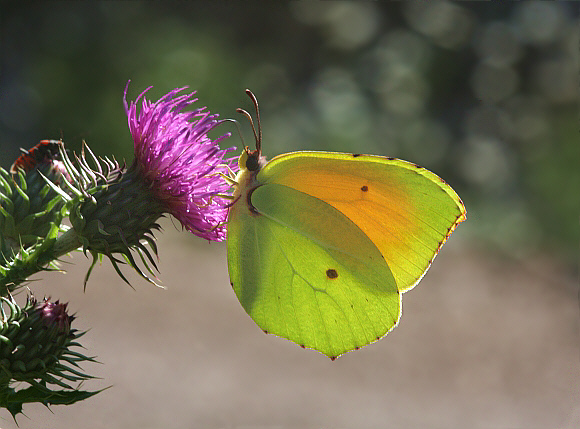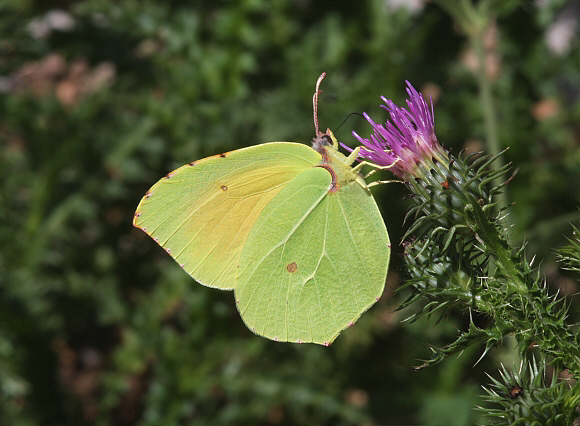 Gonepteryx cleopatra, male, Velebit mts, Croatia – Peter Bruce-Jones
Gonepteryx cleopatra, male, Velebit mts, Croatia – Peter Bruce-Jones
Introduction
There are 10 species in the genus Gonepteryx, distributed variously across Europe and temperate Asia, with 2 species also found in north Africa, and one species nepalensis endemic to Nepal.
All Gonepteryx species share the same distinctive wing shape. The females of most species are pale greenish white in colour, while the males vary according to species from pale primrose yellow in farinosa to deep orange-yellow in amintha. The undersides of all species are pale greenish or yellowish, with raised venation on the hindwings, giving them a leaf-like appearance at rest.
Gonepteryx cleopatra is arguably the most beautiful in the genus, the males being deep yellow on the upperside, flushed on the forewings with orange. Early entomologists listed several subspecies of cleopatra including G. cleopatra cleobule from the Canary Islands, and G. c. maderensis from Madeira, but both are regarded as fully-fledged species by some taxonomists. DNA analysis and phylogenetic comparisons have failed to conclusively prove the case one way or the other.
The Cleopatra is found in the warmer regions of Europe including most of Spain and Portugal, the south of France, Italy, Croatia, southern Greece, Turkey and most Mediterranean islands. Its range extends east to Syria, and also includes the north African counties of Algeria, Morocco and Tunisia.
Throughout most of its range the butterfly is common – I have vivid recollections of driving through Provence in 1995, and seeing dozens flying along the roadsides. Several hit the windscreen, and when I stopped the car I found 6 adults splattered across the bonnet and bumpers. The roadside and nearby rocky ground were covered in the dismembered wings of dozens of other Cleopatras which had been attacked by birds.
 Gonepteryx cleopatra, male, Velebit mts, Croatia – Peter Bruce-Jones
Gonepteryx cleopatra, male, Velebit mts, Croatia – Peter Bruce-Jones
Habitats
Gonepteryx cleopatra is found in warm, dry and often rocky habitats including light deciduous or coniferous woodland, scrubby grassland and roadsides. It is most commonly found at altitudes between sea level and about 1200m, but there are records from as high as 3000m.
The species / subspecies maderensis, cleobule, palmae and eversi are all largely restricted to laurel forests on Madeira or the Canary Islands at altitudes between about 400-1500m.
Lifecycle
Over most of their range the butterflies are single-brooded, emerging in late May, and remaining on the wing until late August. There is uncertainty about the voltinism of the Madeira and Canary Island taxa, which fly at different times – March/April, June to September, and December. This could be the result of polyvoltinism, or it may be the case that in hot regions this long-lived species aestivates in certain months and goes undetected.
Individual butterflies can live for up to 10 months. Between September-February they hibernate, except on Madeira and the Canary Islands, where they fly at low altitudes where temperatures remain high enough for activity even in mid-winter.
The pale greenish-white skittle-shaped eggs are laid singly on the stems, buds or young leaves of buckthorn bushes, chiefly Rhamnus catharticus although alaternus, myrtifolia, oleoides, alpinus, sibthorpianus and persicifolius are also used. On Madeira and the Canary Islands the foodplants are Rhamnus glandulosa and crenulata.
When small, the larvae feed on the underside of the leaves, peppering them with tiny holes. Older larvae can be found resting along the midrib on the upperside of the leaves, with the front half of their bodies arched slightly. Throughout their development they are green, and covered with a sprinkling of short fine hairs.
When ready to pupate, the larva attaches itself by the tail and a thin silk girdle, either to the midrib on the underside of a buckthorn leaf, or more often to a narrow stem away from the foodplant. It hangs in this position for about 24 hours during which the body gradually arches and stiffens prior to moulting the skin, revealing the newly formed chrysalis.
The chrysalis is pale green and is superbly camouflaged. The wing colours of the developing adult can be seen about 3 or 4 days before it emerges.
Adult behaviour
Both sexes nectar at a wide variety of flowers but strongly favour knapweeds and thistles. On the Canary Islands they commonly nectar at Cedronella.
Overnight roosting and hibernation usually take place beneath bramble leaves Rubus fruticosus in mainland Europe and on Madeira, but on the Canary Islands they settle beneath laurel leaves.
It is noteworthy that the mainland and Canary Island races strongly reflect UV from the undersides of their hindwings, just like the bramble leaves beneath which they roost and hibernate. Madeira adults however have non UV-reflective undersides, matching the laurel leaves among which they roost overnight. This is believed to be an evolutionary adaptation that makes it more difficult for UV-sensitive insectivorous birds to locate and devour the butterflies.

Gonepteryx cleopatra, female, Velebit mts, Croatia – Peter Bruce-Jones
